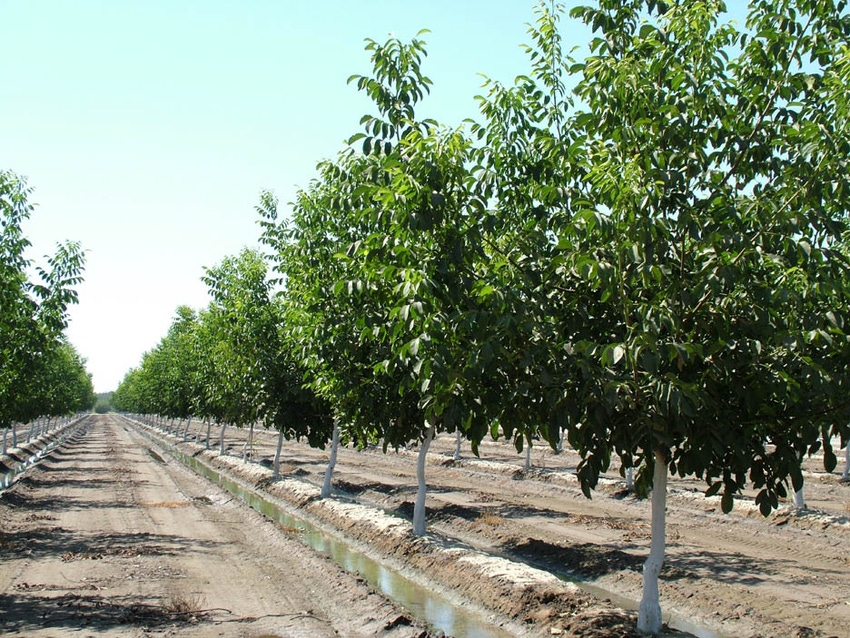
Depending on variety, walnut blight can take a heavy toll on walnut production, particularly when initial inoculum is high and spring weather is warm and wet.
However, with the federal EPA granting Manzate ((flowable or dry flowable formulations) a Section 3 registration last year, walnut growers throughout California now have a reliable option for controlling the disease. For the previous two decades, growers in the state could use this and other ethylene bis-dithio-carbamates (EBDCs) products to treat for walnut blight only in selected counties under a Section 18 (emergency exemption) registration. Applying for Section 18 registration required submitting extensive environmental, health and safety data each year.
The walnut blight bacterium (Xanthomonas arboricola pv juglandis) over-winters in dormant buds primarily under the outer bud scales or cataphylls. When buds break in the spring, cataphylls open and young shoots extend past them. Rain drops spread the disease by splashing bacteria onto any green tissue, infecting them. Early leafing varieties are most susceptible to walnut blight, which tends to be more severe in northern California.
The disease appears as black lesions on green tissue. As bacteria spread inside the walnut, they grow toward the center of the nut early in the season, destroying the developing kernel. Infections later in the season develop randomly, causing so-called side blight. Depending on when this occurs, side blight may or may damage the kernel.
Success in controlling walnut blight requires application of protective sprays to early shoots, flowers, and developing nuts, reports Rick Buchner, University of California Cooperative Extension farm advisor for Tehama County. In orchards with histories of walnut blight damage, protective treatments at seven to 10-day intervals during prolonged wet springs are necessary for adequate disease control. In areas or years with less intensive rainfall, spray intervals can be stretched, and weather forecasts can help with spray timing, he adds.
“Blight treatments work by protecting walnuts from infection,” Buchner says. “They won’t control the disease if applied after infection has already occurred. Copper, tank-mixed with Manzate for each treatment, is currently the best available choice for walnut blight management.”
Four manzate products are available for use in California – two flowable formulations, Manzate Max and Manzate Flowable, and two dry flowable formulations, Manzate Pro-Stick and Penncozeb 75 DF. Each have subtle differences in respirator requirement and treatment interval. If you select one of these products, check with your PCA or Ag Commissioner for label requirements.
From 2010 through 2102, Buchner and his colleagues studied the amount of bacterial inoculum in dormant buds, spray programs and the percent of walnut blight damage for 30 orchards in Butte and Tehama counties. Seven Chandler, six Howard, two Hartley, one Tulare, and one Vina orchard all had very good walnut blight control, he notes.
Blight control
The initial inoculum levels were low and each spray program protected the crop. In contrast, five Chandler, five Howard, two Vina, and one Ashley orchard had poor to very poor walnut blight control.
The researchers attributed the failures in controlling walnut blight to one or more factors:
1) First spray timing was too late.
2) Walnut blight bacterial population increased in dormant buds, resulting in high initial disease pressure.
3) Material rates were too low.
4) Spray coverage both by air and ground was poor.
5) A weak material was used in high-blight potential orchards.
6) Manzate was not tank mixed.
7) Tree canopies were dense.
Based on these findings, Buchner offers several tips for improving walnut blight control this season.
“Our experience still suggests that any good quality copper will provide good control,” he says. “Spray rates vary by copper formulation. Under heavy blight pressure, high label rates are a good idea.”
If blight control was poor last year, it is very likely that bacterial populations are
building, Buchner notes. That adds to the difficulty of controlling the disease.
“Making the first spray application at forty percent prayer stage and a second application seven to 10 days later is the basis for good disease control,” Buchner says.” If you want to be more conservative, apply the first application at 20 percent prayer stage. Either way, the early sprays are critical for success. Additional sprays will be necessary with high inoculum levels and wet weather.”
Good coverage is essential for walnut blight control, he explains. Sprays must cover walnut tissue with enough material to protect the green tissue. It is very likely that half- spray programs are providing the opportunity walnut blight bacteria to thrive, increase populations and destroy walnuts.
“In addition, the half spray-sub lethal exposure approach is an excellent way to continue to select for resistance to the only effective spray program we have for walnut blight,” Buchner says. “Finally, where we have had serious blight damage, it has taken two years with a perfect spray program to beat the disease back down.”
More information on walnut blight control is available online at www.ipm.ucdavis.edu and http://walnutresearch.ucdavis.edu.
About the Author(s)
You May Also Like




